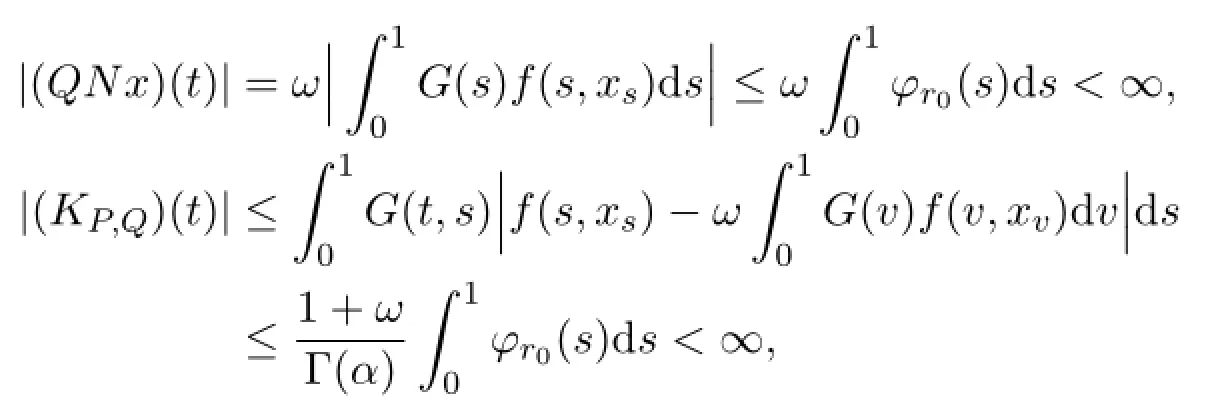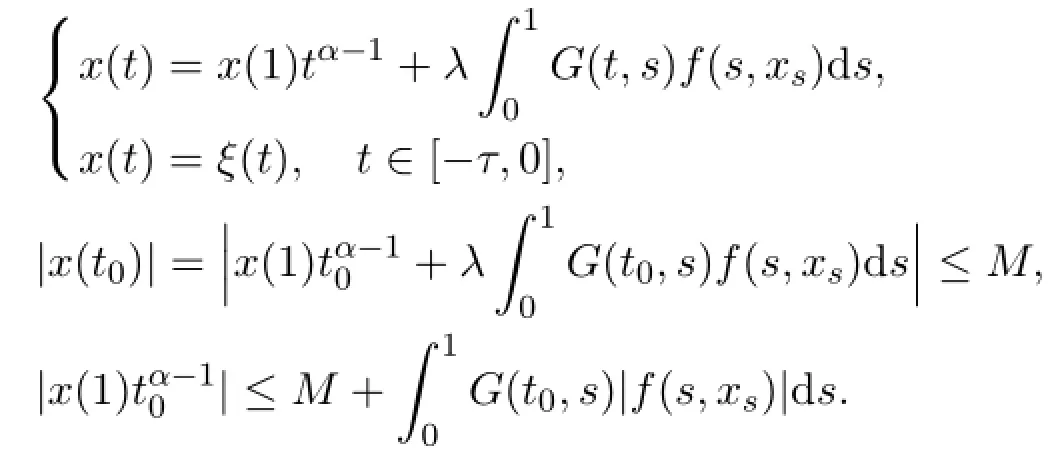SOLVABILITY FOR FRACTIONAL FUNCTIONAL DIFFERENTIAL EQUATION BOUNDARY VALUE PROBLEMS AT RESONANCE∗†
2016-10-14XiangkuiZhaoFengjiaoAnShashaGuo
Xiangkui Zhao,Fengjiao An,Shasha Guo
(School of Math.and Physics,University of Science and Technology Beijing,Beijing 100083,PR China)
SOLVABILITY FOR FRACTIONAL FUNCTIONAL DIFFERENTIAL EQUATION BOUNDARY VALUE PROBLEMS AT RESONANCE∗†
Xiangkui Zhao‡,Fengjiao An,Shasha Guo
(School of Math.and Physics,University of Science and Technology Beijing,Beijing 100083,PR China)
Abstract
The paper deals a fractional functional boundary value problems with integral boundary conditions.Besed on the coincidence degree theory,some existence criteria of solutions at resonance are established.
fractional boundary value problem;at resonance;coincidence degree theory;integral boundary conditions
2000 Mathematics Subject Classification 30E25
1 Introduction
This paper deals the following fractional functional differential equation boundary value problems at resonance

Fractional derivative was introduced by Leibnitz in the email to L'Hospital[1]. It was not developed before the 20th century,since it was short of a physical meaning or application.In recent decades,the researchers have found that the fractionalderivative has long-term memory and self-similarity so that it can be used in electromagnetic,viscoelasticity,and other fields[2-4].Motivated by the widely application of fractional derivative,the fractional differential equations have received a lot of attention.There are a lot of papers dealing with the solutions for fractional differential equation boundary value problems[5-13].
Zhang,Lin and Sun[13]considered the following boundary value problem


has a nontrivial solution u(t)=ctα-1,c∈R.Hence the research method of[13]is not applicable to(1.1)at resonance.Inspired by the above works,we consider(1.1)at resonance in this paper.
2 Preliminary
Some definitions and lemmas are presented which are available in the proof of our main results.
Definition 2.1 The Riemann-Liouville fractional integral of order α for function f is defined as

provided that the right side is point-wise defined on(0,∞).
Definition 2.2 The Riemann-Liouville fractional derivative of order α>0 for function f is defined as

where n=[α]+1,provided that the right side is point-wise defined on(0,∞).
Lemma 2.1[8]Let α>0 and assume that u∈C(0,1)∩L(0,1),then the fractional differential equation

Lemma 2.2[8]Assume that u∈C(0,1)∩L(0,1)with a fractional derivative of order α>0 that belongs to u∈C(0,1)∩L(0,1),then

for some ci∈R,i=1,2,···,N.
Definition 2.3We say that the function f:[0,1]×R→ R satisfies L1-Carath´eodory conditions,if
(1)for each u∈R,t■→f(t,u)is Lebesgue measurable on[0,1];
(2)for almost everywhere t∈[0,1],u■→f(t,u)is continuous on R;
(3)for each r>0,there exists a φr∈L1[0,1]satisfying φr(t)>0 on[0,1]such that<r implies|f(t,u)|≤φr(t),almost everywhere t∈[0,1].
We present the following theorem due to J.Mawhin[14]to obtain the existence results.
Theorem 2.1Let X,Y be two Banach spaces,P:X → X,Q:Y→ Y be continuous projectors with ImP=KerL,KerQ=ImL,X=KerL⊕KerP,Y=ImL⊕ImQ,L:domL⊂X → Y be a Fredholm operator of index zero,L|domL∩KerP:domL∩KerP→ImL is invertible,and N:X→Y be L-compact onAssume that the following conditions are satisfied:
(3)deg(JQN|KerL,Ω∩KerL,0)/=0,where J:ImQ→KerL is any isomorphism. Then the equation Lx=Nx has at least one solution in domL∩
In the paper,we use the space X=C([0,1])with the normand the space Y=L1[0,1]with the normFor each x∈X,we extend x(t)to
Define a linear operator L:domLwith

We get that

by direct calculations.By the definition of L,we have if y∈Im L,there exists an x∈domL such that y=Lx=Hence

Hence y satisfies

That is

with

Therefore


For any y∈Y,let y1=y-Qy,then

Hence y1∈KerQ,that is Y=KerQ+ImQ.If Qy=0,then y∈ImL.Therefore ImL=KerQ and Y=ImL+ImQ.Let y∈ImL∩ImQ and assume that y= c/=0,since y∈ImQ.We get c=0 from∫10G(s)ds/=0,since y∈ImL.Hence Y=ImL⊕ImQ,that is dimKerL=codimImL=1.Therefore L is a Fredholm operator of index zero.
Define a continuous projection P:X→KerL as

It is easy to get P2x=Px,ImP=KerL.Hence X=KerL⊕KerP.Therefore,there is a unique decomposition x(t)=ρtα-1+x1(t)such that ρ∈R and x1∈KerP for every x∈X.Let LP:domL∩KerP→ImL be the restriction of L on domL∩KerP,then LPis invertible.Set KP=L-1P,then

for any y∈ImL with

In fact,it is clear that LKPy=y for y∈ImL.By the definition of domL and KP,we have,if x∈domL∩KerP,then x(0)=x′(0)=x′(0)=x(1)=0,hence
Let a nonlinear operator N:X→Y be defined as

then the boundary value problem(1.1)equals to

with J:ImQ→KerL being an isomorphism.Next,we illustrate thatis bounded and KP,Qis compact with KP,Q=KP(I-Q)N.That is the map N:X→Y is L-compact on
Lemma 2.3If f:[0,1]×R→R satisfies L-Carath´eodory conditions,then N:X→Y is L-compact onwith Ω⊂X.

3 Existence Results
Theorem 3.1 Assume f:[0,1]×R→R satisfies S-Carath´eodory condition. Assume that:
(H1)There exist two functions p,r∈Y such that for all x∈R,t∈[0,1]

with p,r∈Y,(α+µη)∥p∥Y<Γ(α+1);
(H2)there exists a constant M>0 such that if|x(t)|>M for all t∈[η-τ,1]then

(H3)for θ∈KerL,there exists a constant M∗>0 such that if|θ(1)|>M∗,

is satisfied.
Then the boundary value problem(1.1)has at least one solution in X.
Proof Let X,Y,L,N,P,Q be defined as above.Let

If x∈Ω1,then x∈domLKerL,Nx∈ImL=KerQ.Hence

By(H2),there exists a constant t0∈[η-τ,1]such that|x(t0)|≤M.A function x satisfies Lx=λNx if and only if x is a solution of

Hence

Therefore




Therefore

thus Ω1is bounded.
Let

If θ∈Ω2,thenthat is

Let

where J:KerL→ImQ is a linear isomorphism given by J(θ(t))=θ(1).If x∈Ω3and the first part of(H3)holds,then we have

If λ=1,then θ(1)=0,if λ=0,by the first part of(H3),we get that

which is a contradiction,hence,thus Ω3is bounded.
If the second part of(H3)holds,set

Similarly,we can prove that Ω3is bounded.
Let Ω be a bounded open set of X such thatBy Lemma 2.3, N is L-compact onThen
Finally,we illustrate that(3)of Theorem 2.1 is satisfied.Let

according to the above arguments,we know H(x,λ)0,for all x∈(KerL)∩∂Ω,thus,by the homotopy property of degree

Then by Theorem 2.1,Lx=Nx has at least one solution in(domL)∩Hence problem(1.1)has at least one solution.The proof is complete.
4 Example
Example 4.1 Consider the following boundary value problem

where

Corresponding to problem(1.1),we have thatBy simple calculation,we can get that(H1),(H2)and(H3) hold.By Theorem 2.1,problem(4.1)has at least one solution.
References
[1]G.W.Leibnitz.Letter from hanover,germany,september 30,1695 to g.a.L'hospital. Leibnizen Mathematische Schriften.Olms Verlag,Hildesheim,Germany,1962,First published in 1849.
[2]K.S.Miller,B.Ross,An Introduction to the Fractional Calculus and Fractional Differential Equations,Wiley,New York,1993.
[3]I.Podlubny,Fractional Differential Equations,Academic Press,New York,Londen,1999.
[4]A.A.Kilbas,H.R.Srivastava,J.J.Trujillo,Theory and Applications of Fractional Differential Equations,in:North-Holland Math.Studies,vol.44,Elsevier,2006.
[5]A.Babakhani,V.D.Gejji,Existence of positive solutions of nonlinear fractional differential equations,J.Math.Anal.Appl.,278(2003),434-442.
[6]C.S.Goodrich,Existence of a positive solution to systems of differential equations of fractional order,Comput.Math.Appl.,62(2011),1251-1268.
[7]Y.Zhao,S.Sun,Z.Han,Q.Li,The existence of multiple positive solutions for boundary value problems of nonlinear fractional differential equations,Commun.Nonlinear Sci. Numer.Simulat.,16(2011),2086-2097.
[8]Z.Bai,H.L¨u,Positive solutions for boundary value problem of nonlinear fractional differential equation,J.Math.Anal.Appl.,311(2005),495-505.
[9]W.Jiang,Solvability of fractional differential equations with p-Laplacian at resonance,Appl.Math.Comput.,260(2015),48-56.
[10]Y.Liu,S.Chen,L.Ou,Solvability of Sturm-Liouville boundary value problems for multiple order fractional differential equations,Arab J.Math.Sci.,(2015),doi:10.1016/ j.ajmsc.2015.08.001.
[11]R.P.Agarwal,M.Benchohra,S.Hamani,A survey on existence result for boundary value problems of nonlinear fractional differential equations and inclusions,Acta Appl. Math.,109(2010),973-1033.
[12]S.Marano,D.Motreanu,Infinitely many critical points of non-differentiable functions and applications to a Neumann type problem involving the p-aplacian,J.Differ.Equ.,182(2002),108-120.
[13]X.Zhang,L.Wang,Q.Sun,Existence of positive solutions for a class of nonlinear fractional differential equations with integral boundary conditions and a parameter,Appl.Math.Comput.,226(2014),708-718.
[14]J.Mawhin,Topological degree methods in nonlinear boundary value problems,in:NSFCBMS Regional Conference Series in Mathematics,American Mathematical Society,Providence,RI,1979.
(edited by Mengxin He)
∗Supported by the Fundamental Research Funds for the Central Universities.
†Manuscript received December 16,2015;Revised May 30,2016
‡Corresponding author.E-mail:xiangkuizh@ustb.edu.cn
杂志排行
Annals of Applied Mathematics的其它文章
- THE SYMMETRIC POSITIVE SOLUTIONS OF 2n-ORDER BOUNDARY VALUE PROBLEMS ON TIME SCALES∗†
- ALTERING CONNECTIVITY WITH LARGE DEFORMATION MESH FOR LAGRANGIAN METHOD AND ITS APPLICATION IN MULTIPLE MATERIAL SIMULATION∗†
- BIFURCATIONS AND NEW EXACT TRAVELLING WAVE SOLUTIONS OF THE COUPLED NONLINEAR SCHR¨ODINGER-KdV EQUATIONS∗
- OPTIMAL DECAY RATE OF THE COMPRESSIBLE QUANTUM NAVIER-STOKES EQUATIONS∗†
- EFFECTS OF A TOXICANT ON A SINGLE-SPECIES POPULATION WITH PARTIAL POLLUTION TOLERANCE IN A POLLUTED ENVIRONMENT∗†
- L6BOUND FOR BOLTZMANN DIFFUSIVE LIMIT∗
